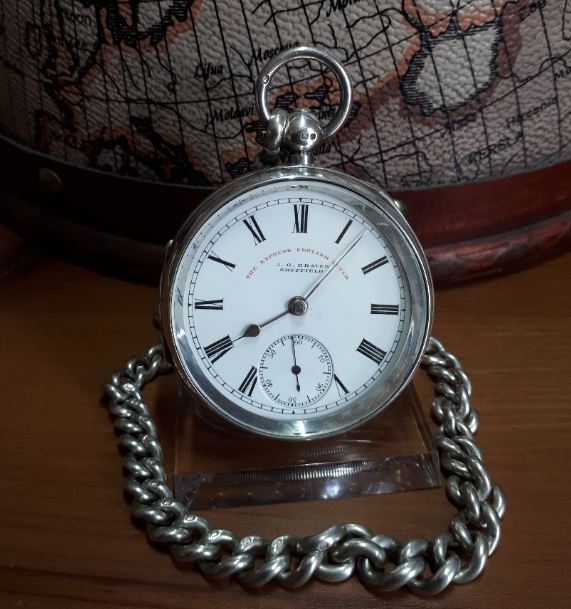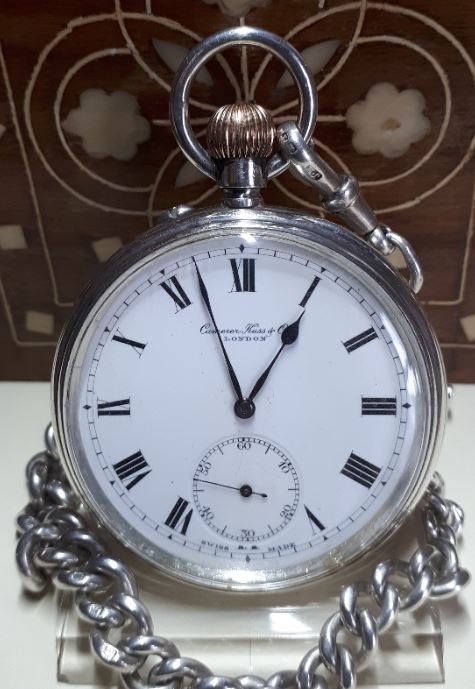Last updated on June 3, 2024
When I first started collecting antique watches, I thought I understood what the term watchmaker referred to, but nothing could be further from the truth. It is a much-abused word. There is more than one definition of a watchmaker that apply depending on where we are in history. This is a brief post about the different types of “watchmakers” you may come across when collecting antique pocket watches.
Definition
By definition, a watchmaker is a craftsman who manufactures and repairs watches. Modern watchmakers typically only repair watches because the majority of watches are now factory-made. However, originally watchmakers were master craftsmen who built watches, including all their components, by hand. This was a time consuming and expensive process. The watchmaker could only produce a low volume of watches because everything was crafted by a single artisan.
The earliest watches appeared in the 16th century. These watches would have been completely manufactured by a single watchmaker. In the 18th and 19th centuries, this began to change. A division of labour had occurred so that there were dozens of specialists involved in the making of a watch. The person who managed the process of assembling the watch components was called the watchmaker. This was despite not having made a single component themselves.
The specialists would all focus on a single component. One man, in his own workshop, would craft mainsprings and nothing else. Another man, again in his own workshop, would fit the hairspring to the balance and nothing else. Neither of these men would be capable of doing the other’s work. In Switzerland, this division of labour was known as the établissage system. A watchmaker who works according to this system is known as an établisseur.
Mechanised manufacturing
In the mid-19th century, American manufacturers entered the watchmaking industry. They introduced a mechanised system of manufacture. This allowed high volumes of components to be produced with consistent quality. The result was reliable, accurate timepieces available in large numbers and at affordable prices. The Swiss manufacturers were quick to follow suit, with the English watchmakers lagging behind. The mechanised system allowed manufacturers to produce blank frames, or ébauches, as they were known in Switzerland. Ébauche movements are essentially unbranded movements that are sold to watchmakers for finishing. The watchmakers would then embellish the movement by polishing or branding and assembling the components. They would then fit them into a pocket watch case and sell them to the unsuspecting public, who thought they were buying directly from the watchmaker.
Retailers
The term watchmaker becomes even murkier when we start considering the high street retailers. The shops that sold watches to the public often used the term “watchmaker” to impress their customers. The vast majority of these establishments never actually made watches, or if they did it was a long time in the past. The terms are still used today by high street retailers as a marketing ploy. The retailers ordered their watches from the watchmaker with the retailer’s brand printed on the dial and sometimes engraved on the movement.
The perfect example of such a retailer is Fattorini & Sons from a post I have written recently. Sometimes it is possible to discover who made the ébauche by looking for markings on the pillar plate. The pillar plate sits underneath the dial and cannot be seen without dismantling the watch. This is unlikely to be done by anyone without specialist skills and tools.
We end up with three definitions of a watchmaker. Each term becomes more tenuous as it moves further from the original. In the 16th and 17th centuries, the term referred to a craftsman who created an entire watch by hand. It changes as we move into the 18th and 19th centuries. The term now refers to the person who collects the watch components from dozens of specialist craftsmen and oversees the assembly. Finally, we have the high street retailers who merely marketed themselves as watchmakers. Therefore the definition of a watchmaker is varied.
Related content
A list of additional posts regarding antique watches can be found on the Guides page.



I have a watch with J W Benson, London and Swiss Made on the dial. Can you please tell me who made the watch?
Hi Carl, JW Benson made some of their own watches in their early days. However, they moved into retail and sold good quality Swiss Made watches using the JW Benson brand, your watch is most likely a Revue Thommen or Cyma watch. Thanks for commenting, Jason.
Thanks for the post. I always assumed that the name on the dial indicated the watchmaker who actually manufactured the watch. Clearly not so!
Interesting, I always thought the name on the dial was the maker of the watch, I stand corrected. I have an antique watch which is a family heirloom from the 1920s, it has J W Benson, London, Swiss Made on the dial, who was the likely watchmaker? Is it likely to be worth very much, not that I would ever sell it. Thanks.